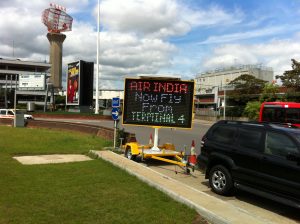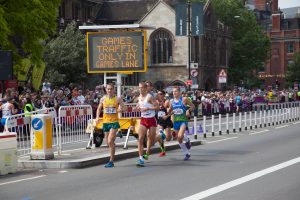Whether you’re organising a small country show or a major music festival, an efficient traffic management system is essential to ensure the smooth flow of traffic to and from the event, maximising visitor satisfaction and minimising the impact on non-event traffic. Many events are located in rural areas, via B-road access, where a good traffic management system is especially important.
Tony Price MD of MVIS recently talked to Events Industry News about his top tips for the smooth running of an event.
“Rapid technological developments in the traffic management industry have given events organisers the opportunity to incorporate state-of- the art equipment into their traffic management systems, equipment that will not only help the traffic to flow more smoothly, but that will also help to save on manpower costs.
“Variable Message Signs (VMS) backed up by the right software can save you a lot of money. These signs are of high impact, and when supported by the right software, can allow you not only to display directional messages but also to update them quickly and easily from any internet enabled device. Their impact and efficient communication capacity means that they can be deployed in fewer numbers than standard static signs, reducing the need for the high manpower costs often associated with sign installation and management.
“Tests have shown that VMS signs displaying messages using a wide variety of colours have particularly high impact, allowing drivers to interpret instructions with the greatest speed. MVIS’ matrix signs are capable of displaying text in five colours, although TSRGD 2002 regulations meant that on the Olympic Route Network, only amber and white were permissible. We are currently lobbying the Department for Transport and the Highways Agency to permit the use of greater colour in order to improve traffic management efficiency.
“One mistake that events transport managers often make is to think no further than signage. In fact, solutions incorporating a range of ITS products can be used to help make the traffic flow more efficiently. CCTV, radar and Automatic Number Plate Recognition systems can all be employed on the routes leading to the event in order to capture information that will help you to manage event traffic well.
“For example, these products can count and instantly transmit to you details of the number of vehicles approaching the event, thereby allowing you to open up more car-parking spaces as necessary, so preventing tail-backs. ANPR systems can be used to facilitate cashless parking systems, removing the need for barriers, again helping to prevent tail-backs.
“There is a massive array of ITS products on the market, and you need to think carefully about the products that are best for you. Consider whether the equipment is portable and easy to install. These aspects are vital, not only to ensure efficient initial deployment requiring only a low level of human resource, but also to facilitate the swift redeployment sometimes required due to changing circumstances. Consider too the power supply. As any event organiser will know, external power supplies are not always reliable, so solar powered equipment is by far the best option.
“Also, think about whether the combination of ITS technology you choose can be housed in one platform rather than several, as this will save you money. Our new Solar 2012 multi-use trailer platform facilitates the mounting of multiple products on a single, solar powered, mobile platform, allowing the flexible combination of a selection of temporary ITS equipment.
“Finally, when selecting your ITS provider, you should always take care to choose one offering a committed customer service, not just the products themselves. Choose a supplier who is able to give comprehensive operational training, who will be there for you at short notice, and who can be relied on to deliver quickly.”
Tony Price, Managing director, MVIS





